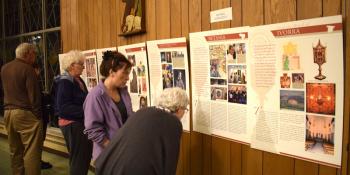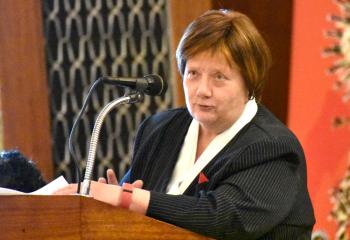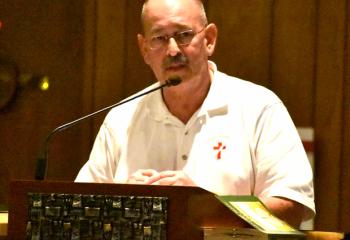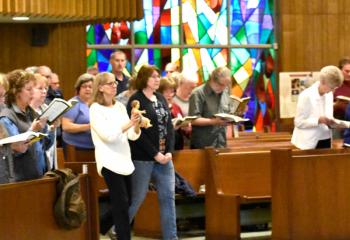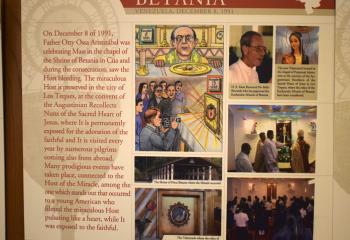By TAMI QUIGLEY Staff writer
St. Ursula, Fountain Hill offered a parish mission for its 100th anniversary in honor of Jesus Christ that highlighted Eucharistic miracles as the mission launched Palm Sunday evening, April 14.
The mission ran April 14-16, and visitors were able to read 85 Eucharistic miracle posters hanging around the Church.
Dr. Annamae Hein spoke April 14 on the Vatican International Eucharistic Miracle Exhibition. Hein retired as a science teacher from Dieruff High School, Allentown and with Rose Neimeister, is a parish secretary at St. Ursula.
The International Vatican Eucharistic Miracle Exhibition is printed from free DVDs issued by this organization after minimal procedures. It is administered by volunteers like Hein, scattered across the world.
It was inspired by a young boy, Venerable Carlo Acutis (1991-2006), who lived his life for Jesus. He and his mother, Antonia Salzano Acutis, researched each miracle and created the exhibit. Monsignor Rafaello Martinelli promoted the exhibition and brought it to the world. Carlo died in 2006 from leukemia at age 15.
The formal introduction of Carlo’s cause for canonization came May 13, 2013 and he became titled as a Servant of God. Pope Francis declared him venerable July 5, 2018.
Information can be found on the official website of the Carlo Acutis Association and the Cause of Beatification of the Venerable Servant of God Carlo Acutis,
“Carlos declared the Eucharist his ‘highway to heaven,’” Hein said.
Deacon David Rohner of St. Ursula offered “Introduction to Eucharistic Miracles Presentation,” during which he spoke of transubstantiation, the conversion of the substance of the Eucharistic elements into the body and blood of Christ. “Some of our fellow Christians believe this is a symbol, but we as Catholics know it’s the body and blood of Christ.”
“The reason we brought the baby Jesus in procession on the first evening of our parish mission on the Eucharist during Lent is that we wanted to remind people that Jesus was born a man just like all of us with Mary’s ‘yes’ to God,” Deacon Rohner said.
“He grew up just as we have: he laughed, he cried, he played with other kids, he felt pain, he loved his mother and father, he mourned his stepfather’s death (Joseph), and he grew up steeped in his Jewish faith knowing the law.
“It was a way to begin our parish mission of the Eucharist from his birth to his death and resurrection as each evening progressed.”
Deacon Rohner also led the discussion “What is the Eucharist to Catholics?” at the close of the evening.
As Hein began her presentation, she said Auxiliary Bishop Robert Barron of Los Angeles has said appearance is not reality.
“In the night sky you see lots of stars. You zero in on one, but you’re not seeing it as it really is. The star had to travel 35,000 light years to get to our eyes. We see starlight that has traveled a far distance and for a long time,” Hein said. “When we wish upon a star we’re time traveling.”
With transubstantiation, “Father Barron says it comes down to the power of words. The appearance of bread and wine is not reality because of the authenticity of the words,” Hein said.
Hein referred to John 6:48-69, and specifically quoted John 6:51 when Jesus said: “I am the living bread which came down from heaven: if any man eat of this bread, he shall live forever.”
“This confused the disciples. They didn’t know whether to take him literally,” she said.
Hein also referenced John 6:53: “Jesus said to them, Amen, amen, I say to you, unless you eat the flesh of the Son of Man and drink his blood, you do not have life within you.”
“At the consecration the priest quotes the direct words of Christ and it changes the reality.”
The Eucharistic miracles are available for online study by clicking here.
This traveling Exhibition of the Eucharistic Miracles is available for organizations to display to their communities at no cost.
The complete exhibition is comprised of 173 posters representing 109 Eucharistic miracles and their locations around the world. Donations for printing costs are appreciated. For more information, call St. Ursula, 610-867-5122.
“We hope to bring this exhibition to as many people as possible,” Hein said. Samples showed muscle cells and intact white blood cells; white blood cells disintegrate after 15 minutes, and this test was done six years after the miracle occurred.
Hein then detailed several Eucharistic miracles.
Sister Rose Mulligan, a Sister, Servant of the Immaculate Heart of Mary, spoke on the Shroud of Turin April 15. People could continue to visit the Eucharistic exhibition.
The exhibition continued April 16, along with adoration and Benediction of the Holy Eucharist. The CCD children performed a dramatic Stations of the Cross.
Also, the day prior to the mission, April 13, and Sunday morning, Palm Sunday, visitors could view the posters.
Eucharistic Miracle of Bolsena-Orvieto, Italy
Hein said this is the Eucharistic miracle that led to the Feast of Corpus Christi.
Hein said among the miracle posters is this story from 1263, when Peter of Prague, a pious German priest, was having doubts about the transubstantiation of the Holy Eucharist. Because this is the heart of our Catholic faith, he was questioning his priesthood vocation.
He decided to make a pilgrimage to the tomb of St. Peter in Rome to pray for enlightenment. He stopped along the way to celebrate Mass at the tomb of St. Christina in the Basilica of Bolsena, Italy.
When he raised his arms to consecrate the host it began to bleed and ran down his hands onto the corporal beneath. At first he tried to hide the blood, but soon he interrupted Mass and asked that he be taken to where Pope Urban IV was residing in nearby Orvieto. As he left the church some of the blood fell and stained the marble floor.
Those who traveled faster than he told the Pope of the miracle. Urban IV decided to intercept the priest himself. They met at the Bridge of the Sun, where the Pope knelt in adoration. The Feast of Corpus Christi was declared on Aug. 11, 1264.
Although more than 750 years old, the Holy Corporal with the Blood of Christ can be visited in the Cathedral of Orvieto, Italy on the altar of the Golden Shrine. The Feast of Corpus Christi will be celebrated this year on June 20, the Thursday after Trinity Sunday.
Eucharistic Miracle of Lanciano, Italy
Hein said another very famous Eucharistic miracle occurred in Lanciano, Italy in 750 A.D. While saying the words of consecration, a doubting priest witnessed the host turn into flesh and the wine turn into blood. This miracle has been extensively studied throughout history and as late as 1970 by Dr. Edward Linoli, the director of a hospital in Arrezo and a professor of anatomy, histology, chemistry, and clinical microscopy.
His findings were later corroborated through 500 tests done by other expert scientists from the Medical Commission of the World Health Organization. The findings were published in December, 1976.
These tests found that the flesh was striated tissue of human heart muscle with white blood cells that indicated they were taken from a living heart under great duress. The blood contained a normal distribution of proteins and responded during clinical testing just as living tissue. It is type AB, the same as the Shroud of Turin. When the globules of blood are weighed separately or together they consistently weigh the same 15.85 grams.
The relics are sealed for security but are not air tight. Testing also revealed no sign of salt preservation even though it is now 1,269 years old. This miracle can be visited at the Sanctuary of the Eucharistic Miracle, Lanciano, Italy. The official website is https://thecatholictravelguide.com/destinations/italy/lanciano-italy-eucharistic-miracle-lanciano/ .
Eucharistic Miracle of Betania, Venezuela
Hein also spoke of this Eucharistic miracle that occurred during the midnight Mass of Dec. 8, 1991.
Father Otty Ossa Aristizabal was celebrating Mass in the chapel of the Shrine of Betania in Cua and during the consecration, saw the host bleeding. The miraculous host is preserved in the city of Los Teques, at the convent of the Augustinian Recollects Nuns of the Sacred Heart of Jesus, where it is permanently exposed for the adoration of the faithful and it is visited every year by numerous pilgrims coming also from abroad.
Tests confirmed the blood of the priest did not match the one of the particle, and that the blood was human type AB positive, matching the one found in the cloth of the Shroud of Turin and in the host of the Eucharistic Miracle of Lanciano.
Many prodigious events have taken place connected to the host of the miracle, among the one which stands out that occurred to a young American who filmed the miraculous host pulsating like a heart, while it was exposed to the faithful.
On Nov. 12, 1998, Daniel Sanford, a pilgrim from New Jersey, saw the host as if in flames in the tabernacle, with a pulsating heart that was bleeding in its center. Hein showed a clip of Sanford’s film to those gathered at St. Ursula.
Eucharistic Miracle of Buenos Aires, Argentina
The parish of St. Mary in Buenos Aires has been the protagonist of three Eucharistic miracles that occurred in 1992, 1994 and 1996. Professor Ricardo Castanon Gomez was called by Cardinal Jorge Maria Bergoglio, then Archbishop of Buenos Aires – now Pope Francis – to analyze the miracle that occurred Aug. 15, 1996.
During Mass on the Feast of the Assumption, a consecrated host fell to the ground and was placed in a vessel of water to dissolve. On Aug. 26 a Eucharistic minister opened the tabernacle and saw the host had blood.
Analysis showed it was human blood and that it presented the entire leukocyte formula; the white blood cells were active.
Further analyses showed the samples were tissues of the heart, similar to those of the studies performed on the host of the Miracle of Lanciano. Samples showed muscle cells and intact white blood cells; white blood cells disintegrate after 15 minutes, and this test was done six years after the miracle occurred. The cells were inflamed and it is the left ventricle of the heart.
The relic of the miracle is preserved in the tabernacle at the Church of St. Mary.



